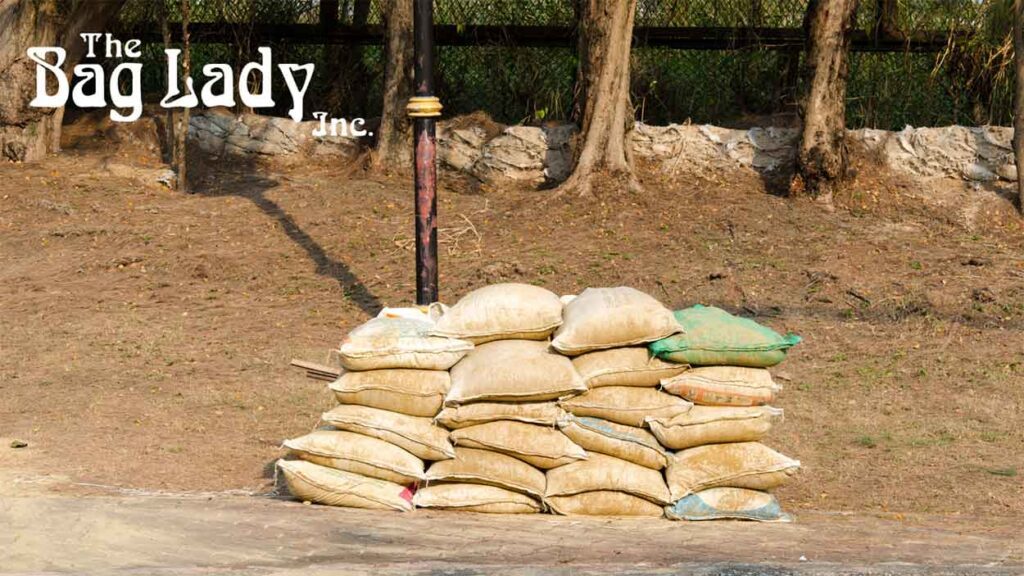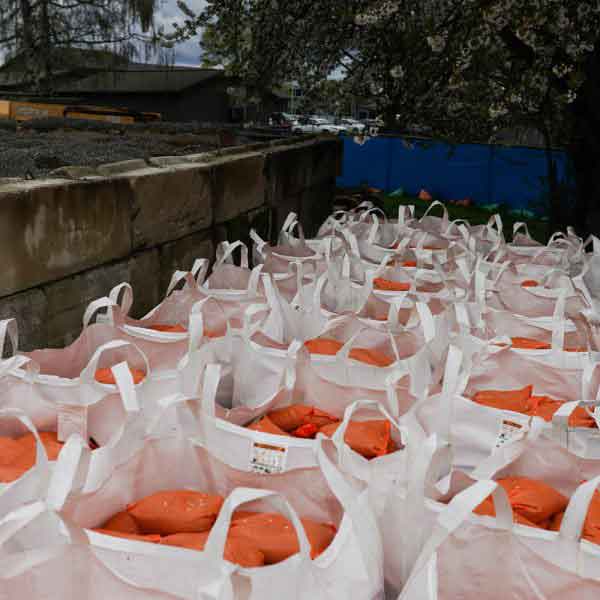Flooding can damage homes, destroy belongings, and leave families displaced. When heavy rain or storm surges hit, you need quick solutions. Many turn to sandbags as a first line of defense, but do they actually work?
In this post, we’ll look at how they work, when they help most, and the mistakes that can make them fail. You’ll also learn when to consider other options and how to use sandbags for flooding the right way.
How Sandbags Work to Stop Floodwater
Sandbags are sturdy sacks, usually made from burlap or polypropylene, that are filled with sand or soil. They’re used to create makeshift barriers that hold back or redirect rising water. These simple tools are a common emergency solution during floods because they’re cheap, flexible, and easy to stack.
They may look basic, but when used correctly, they can make a big difference. Here’s how they work to help keep water out:
Absorbing Water Weight
Each filled sandbag naturally absorbs some of the water it comes into contact with. As the bag soaks up moisture, it becomes heavier and settles more firmly in place.
This added weight helps anchor the bag to the ground, making it less likely to float, shift, or collapse under pressure. The extra stability is crucial during fast-moving floods, where lighter barriers would be pushed aside or toppled easily.
Forming a Tight Seal
When you stack sandbags in a staggered, brick-like pattern, the seams between each bag overlap. This overlapping design helps close off gaps that water might otherwise slip through.
As water presses against the wall of bags, the sand inside settles and compresses, tightening the seal even more. While a few drops may still seep through, this setup slows the flow and stops the majority of the water from getting past.
Pressure Resistance
Floodwater creates strong pressure, especially when it builds up against a structure like a door or wall. The weight and bulk of sandbags help spread that pressure out over a wider area instead of letting it concentrate in one weak spot. This even distribution helps reduce damage to buildings and gives you more time to reinforce other parts of your property or evacuate if needed.
Flexibility on Uneven Ground
Unlike hard barriers that need flat surfaces to work well, bags of sand mold to whatever surface they’re placed on. If you’re dealing with gravel, soil, or cracked pavement, the bags adjust to fit the shape of the ground.
You can also stack them around corners, across slopes, or over steps without leaving large gaps. This flexibility makes them ideal for protecting homes, sheds, or low entryways that don’t have perfectly flat surroundings.
How Much Can Sandbags Hold Back?
Sandbags for flooding work best in situations where water levels are not too high. When used properly, they can block or slow down the flow of water in small-scale flooding. A single layer of tightly packed sandbags can stop several inches of water, making them useful for protecting doorways, garages, and low entry points.
If you stack them in multiple layers, usually in a pyramid shape, they can hold up to two feet of water. This setup can protect small structures or create a barrier around specific areas like a shed or a crawl space. However, their strength has limits.
Beyond the two-foot mark, the pressure from rising water increases significantly. At that point, the sandbags may start to shift, leak, or collapse, especially if they aren’t placed on level ground or sealed properly.
Common Mistakes That Reduce Sandbag Effectiveness
Sandbags are only as good as how you use them. Even with the best materials, a poor setup can lead to leaks, structural collapse, or total failure during a flood.
Many people unintentionally leave gaps in their defense by rushing, skipping steps, or using the wrong technique. Here’s what to watch for:
- Using Unfilled or Underfilled Bags
Each sandbag should be filled about halfway, or around 30 to 40 pounds. This makes the bag heavy enough to stay in place, while still flexible enough to mold into gaps.
Overfilling makes stacking harder and less stable. Underfilled bags don’t block water effectively and are more likely to shift.
- Incorrect Stacking
Don’t stack bags in a straight vertical line. Place them in a staggered, brick-like pattern with each new layer overlapping the one below it. This method adds strength, limits movement, and prevents weak points from forming under pressure.
- Starting Too Late
If you wait until the water is already rising, it may be too late to build a complete barrier. Sandbagging takes time and planning. Set up before the storm hits to avoid last-minute scrambling when water is already threatening your property.
- Not Sealing Gaps
Even small spaces between bags can allow water to trickle in. Always press bags tightly together and check for gaps. Use plastic sheeting behind or on top of the wall for added protection. A tight seal slows seepage and keeps the barrier stronger for longer.
- Failing to Anchor the Base
The first row is the most important. If it’s not level or tightly packed, the entire wall is at risk of collapsing. Ensure the base layer is flush with the ground, with bags pressed tightly end-to-end. A solid base gives your sandbag wall the stability it needs to hold back pressure.
Best Situations to Use Sandbags for Flood Defense
Sandbags work best as a short-term solution in low to moderate flooding. They’re ideal for quick setups and spot protection rather than large-scale barriers.
If you’re dealing with fast-approaching storms or limited resources, they can offer a simple way to keep water away from critical spots. Below are the most common and practical times to use them:
- Flash floods that rise quickly, but not over two feet
- Doorways, garages, or small entryways are vulnerable to runoff
- Protecting specific areas like sheds, crawlspaces, or garden walls
- Temporary fixes before permanent barriers are installed
- Emergency response during storms or hurricane prep
- Rural or off-grid properties without other flood defenses
Are There More Reliable Flood Prevention Tools?
For companies and public agencies preparing for severe weather, traditional sandbags can fall short. Modern solutions like water-filled barriers and modular flood panels offer faster deployment and stronger protection.
These systems are especially useful for businesses with large storefronts, warehouses, or facilities near flood zones. Inflatable seals for doors and gates can also provide a tight, reusable seal that reduces long-term cleanup.
Unlike sandbags, these tools are designed for repeated use, making them a better fit for large operations and critical infrastructure. One major upgrade for flood prep is using a sandbag filler, which saves time and ensures every bag is packed evenly and correctly.
For larger-scale efforts, especially in municipalities, utility companies, or commercial properties, volume matters. A high-capacity sandbag loader is ideal in these situations, allowing teams to fill hundreds of sandbags quickly and consistently. This tool improves response time and efficiency, especially during emergency weather events.
How We Can Help?
The Bag Lady is a trusted supplier of sandbags for both construction and flood prevention. We’ve built long-standing partnerships with suppliers and businesses throughout Washington, including local authorities who rely on our sandbags during emergency response and infrastructure projects. Known as a leading provider in the region, we’re proud to offer a wide range of high-quality burlap and polypropylene sandbags that perform in both routine and extreme conditions.
Our sandbags come in multiple sizes and can be pre-filled by our team to save you time and effort. For large-scale preparation, we use bulk bag filler equipment to handle high-volume orders efficiently—ideal for city operations, contractors, and facility managers.
Order high-quality sandbags from The Bag Lady, trusted by Washington businesses for over 30 years. Contact us and get the right protection in place before the next storm hits.
FAQs
Do I need special training to use sandbags?
No, but it helps to learn the correct stacking method to avoid leaks and wasted effort.
How long do sandbags last?
Most last up to a year outdoors, but military sandbags or treated ones may hold up longer.
Can I reuse sandbags?
Only if they’re dry and undamaged. Flood-soaked bags should be disposed of safely.
Are sandbags safe for indoor use?
Yes, but place them with care to avoid staining floors or damaging furniture.
Where can I buy sandbags quickly?
You can get sand bags, filled sand bags, and bulk bag filler kits directly from The Bag Lady. Call us on (253) 733-1040 or 1-888-770-BAGS(2247).



